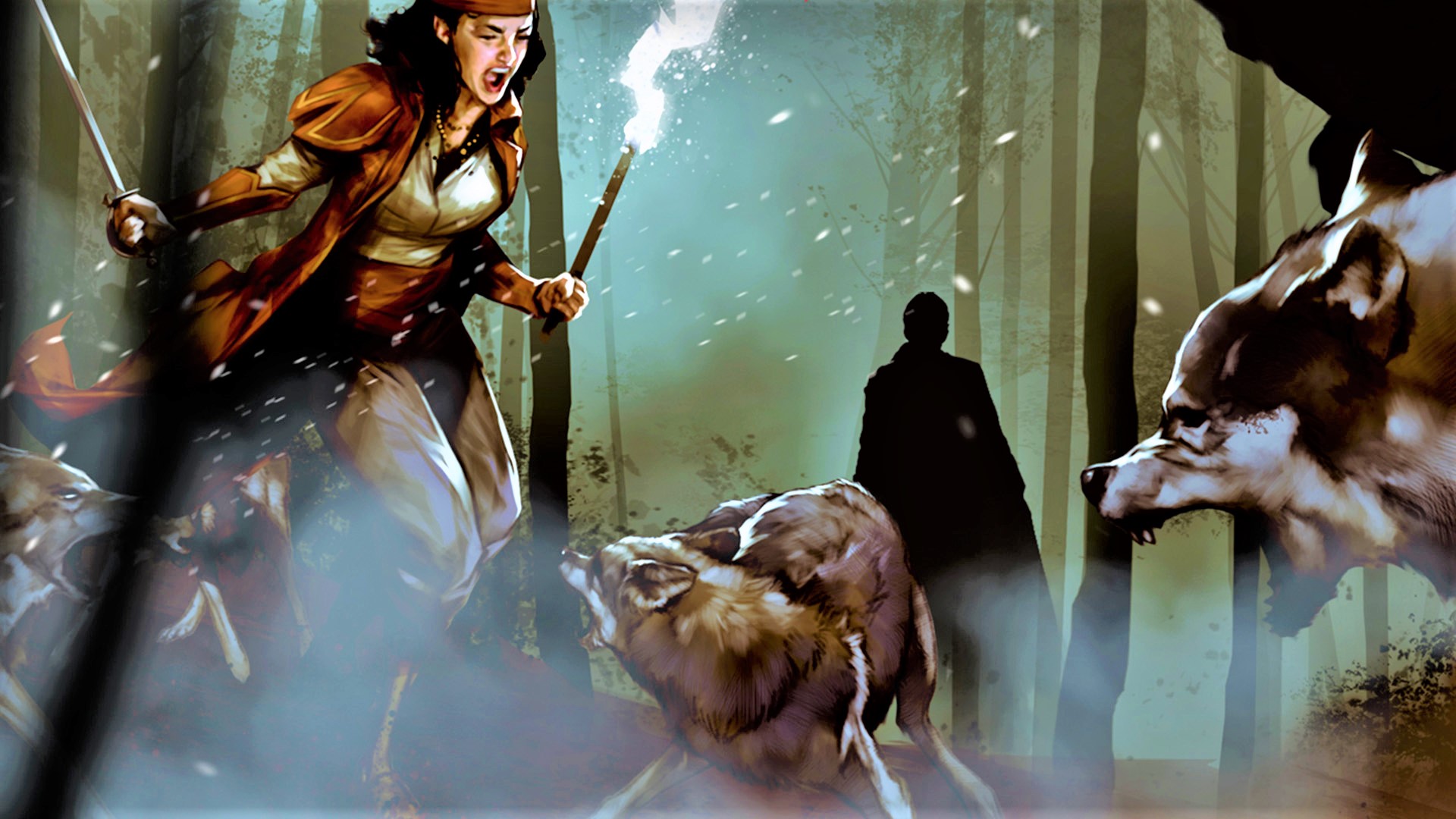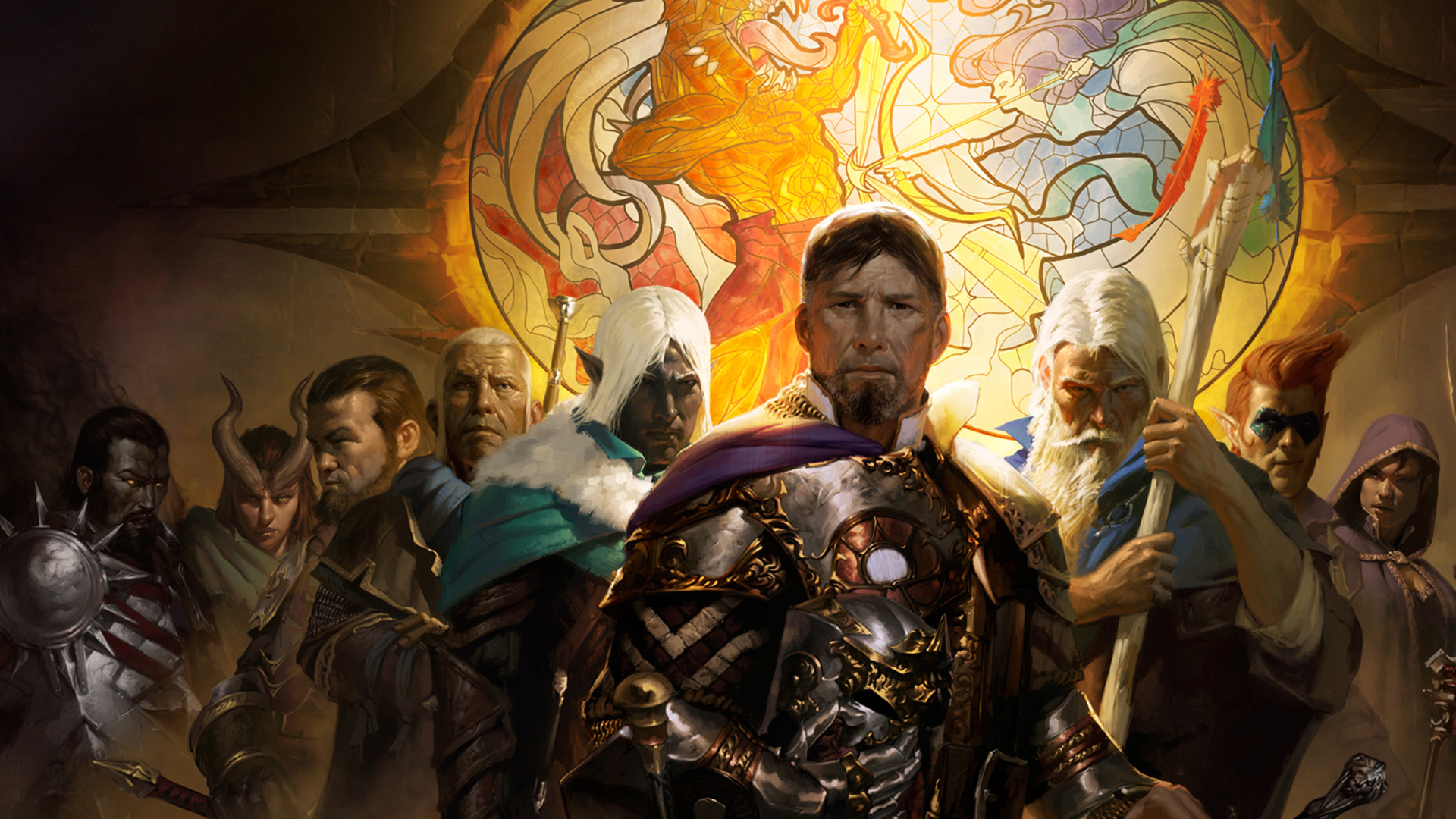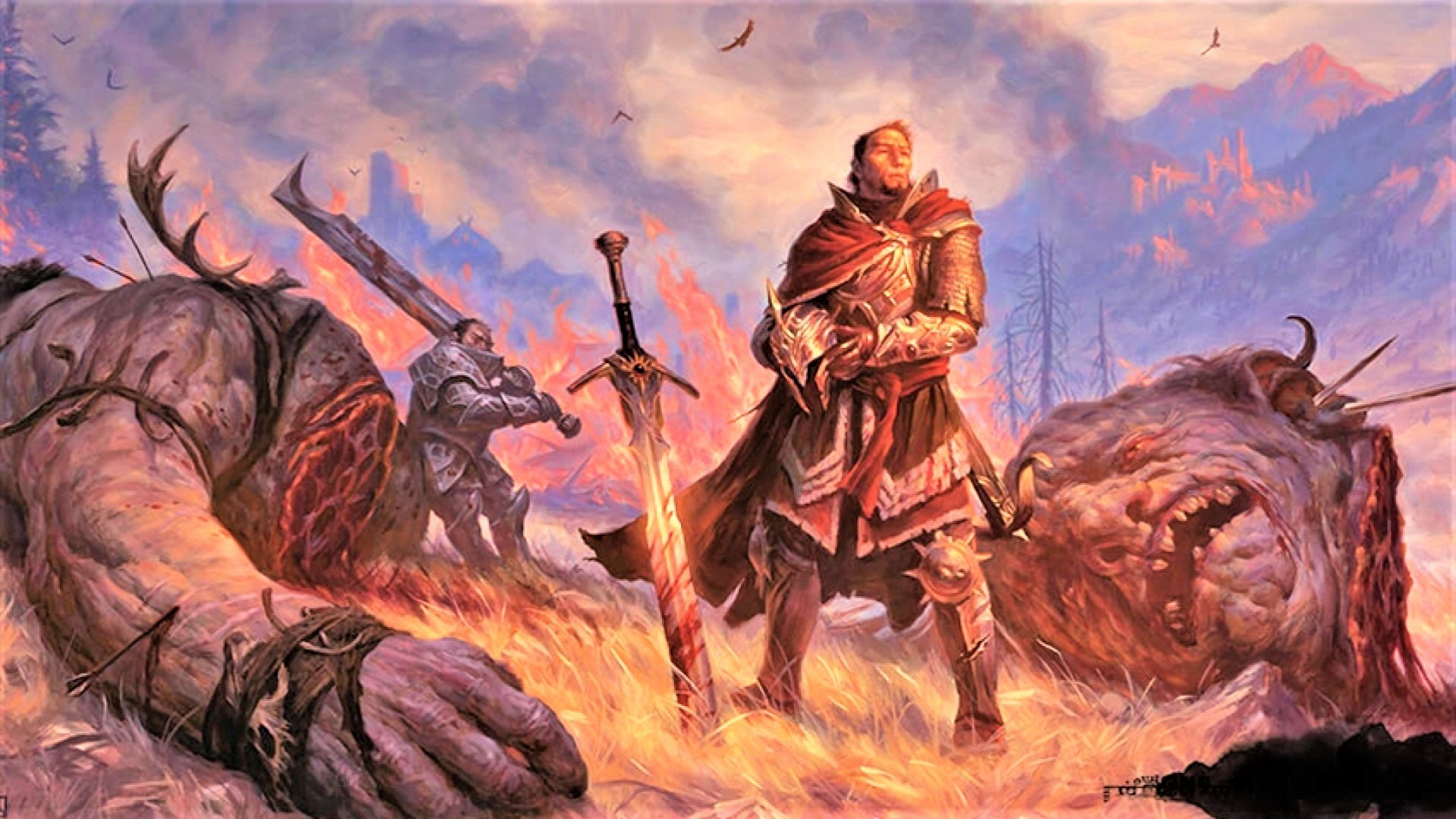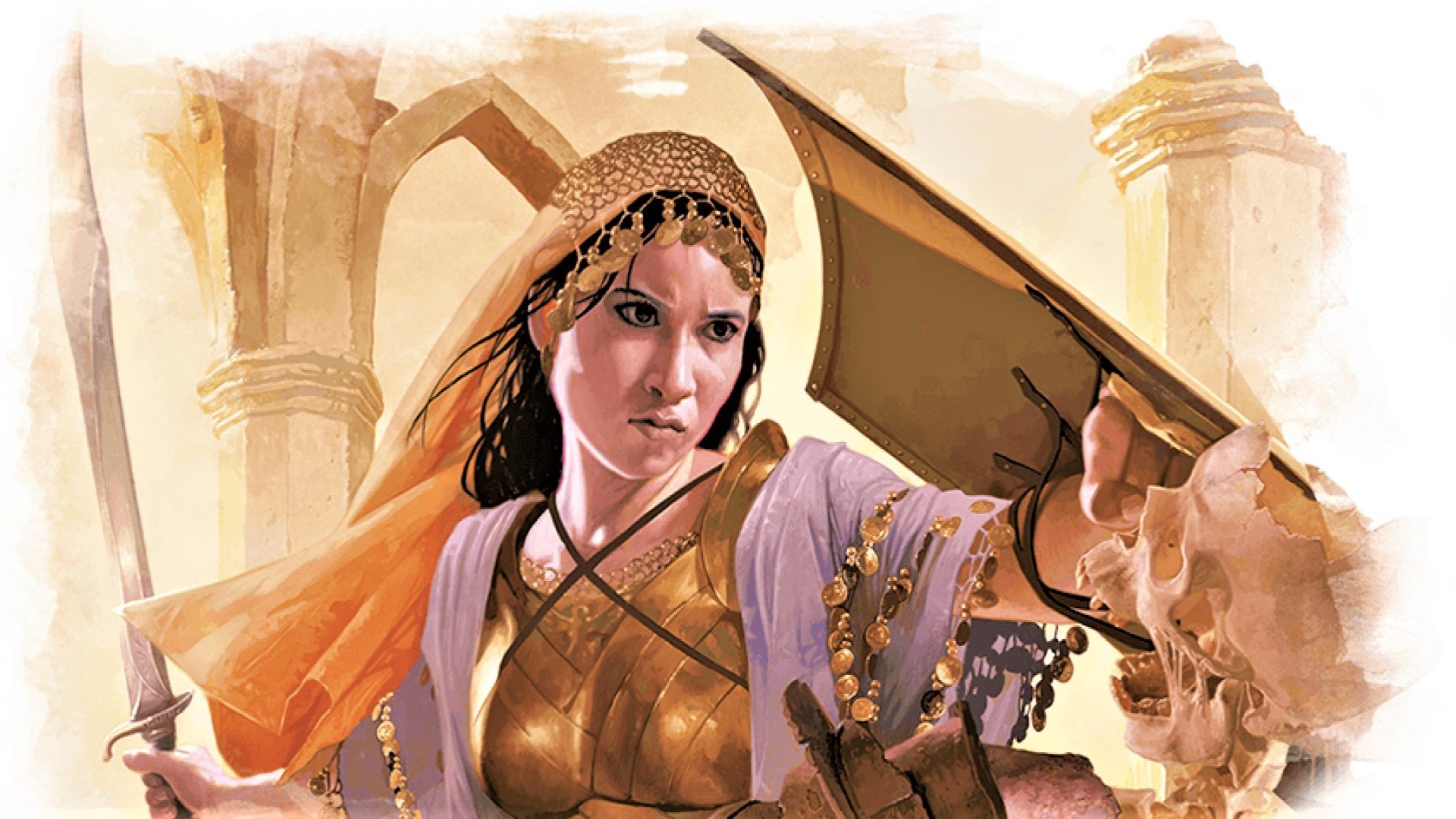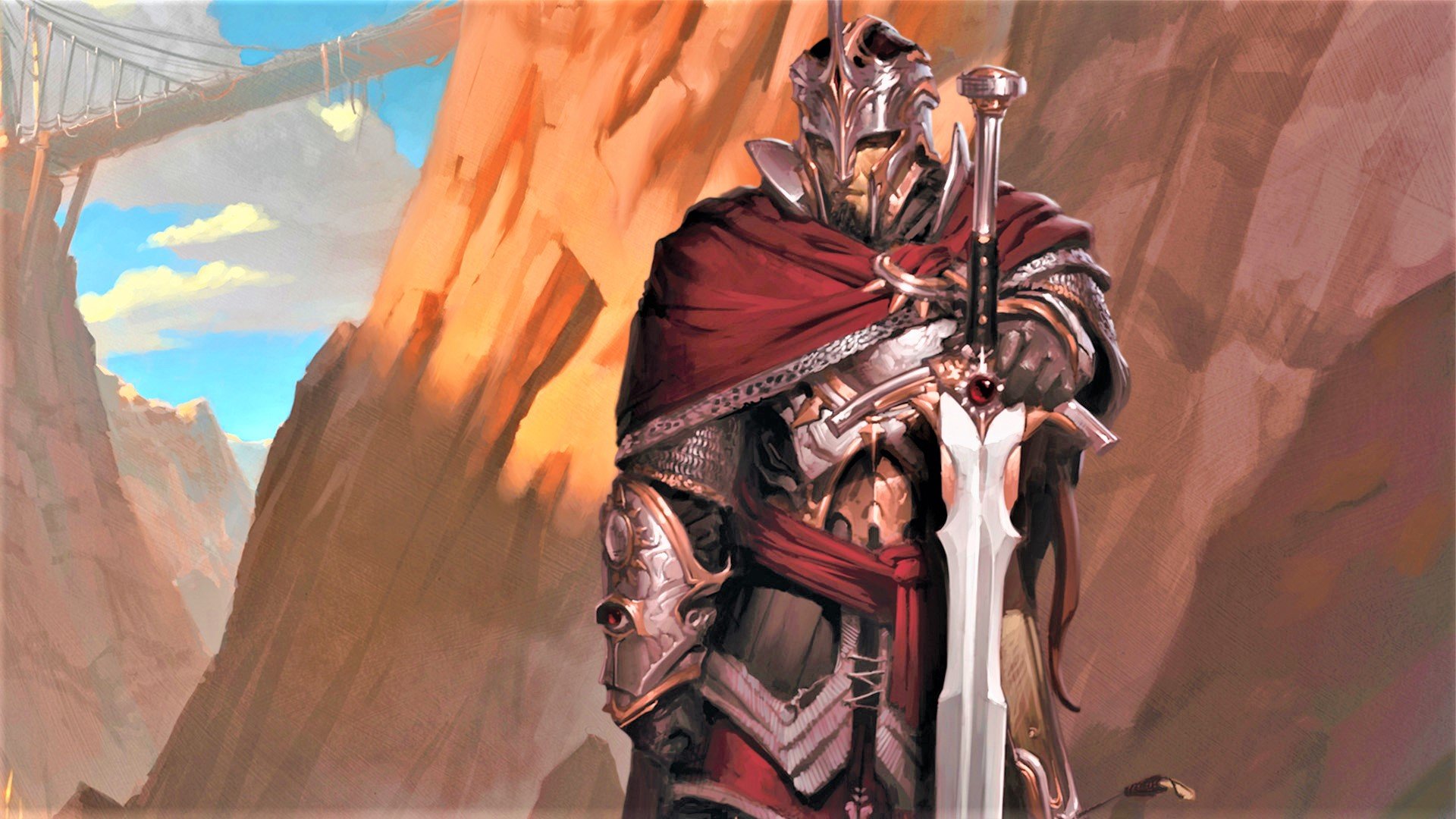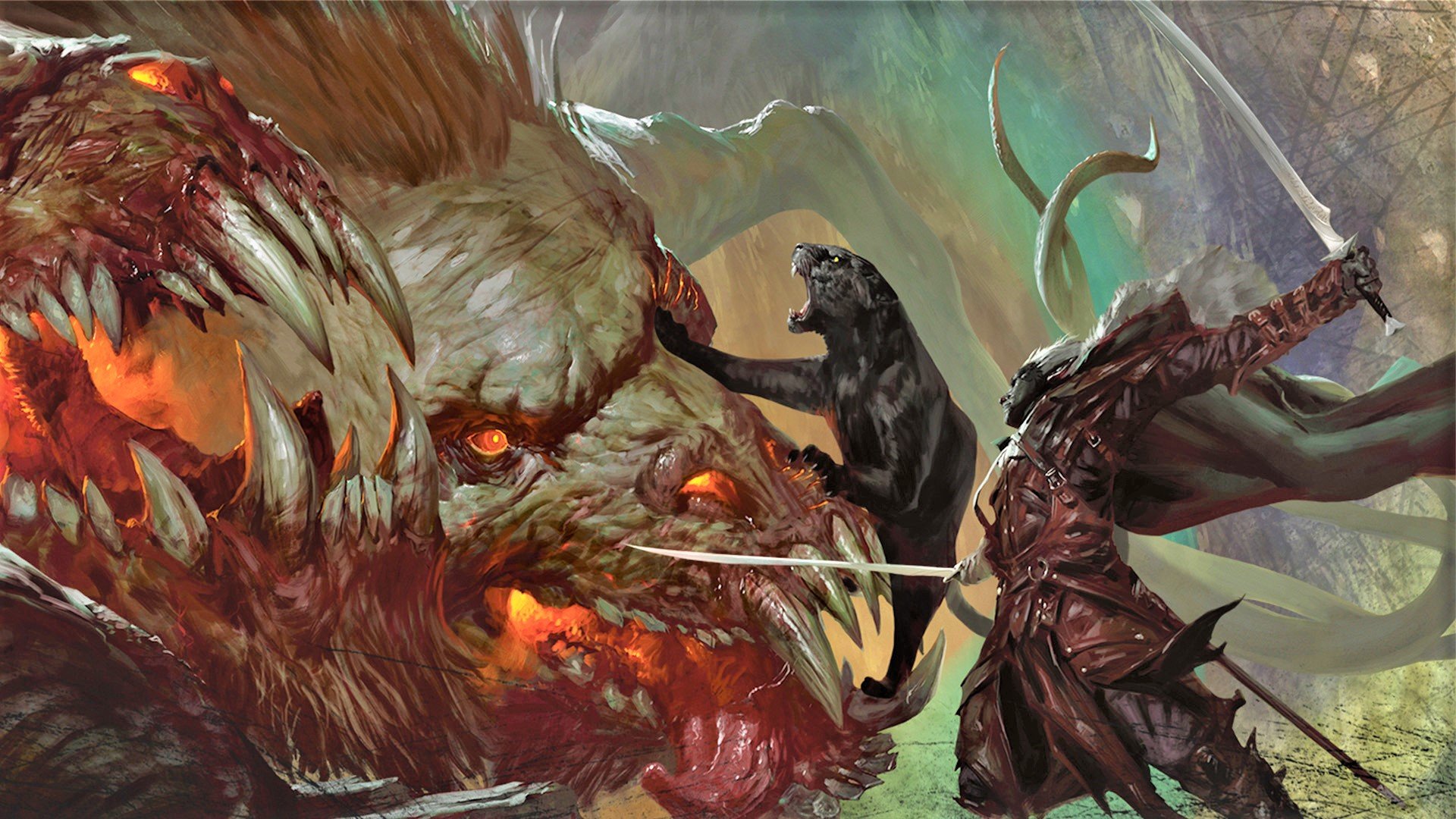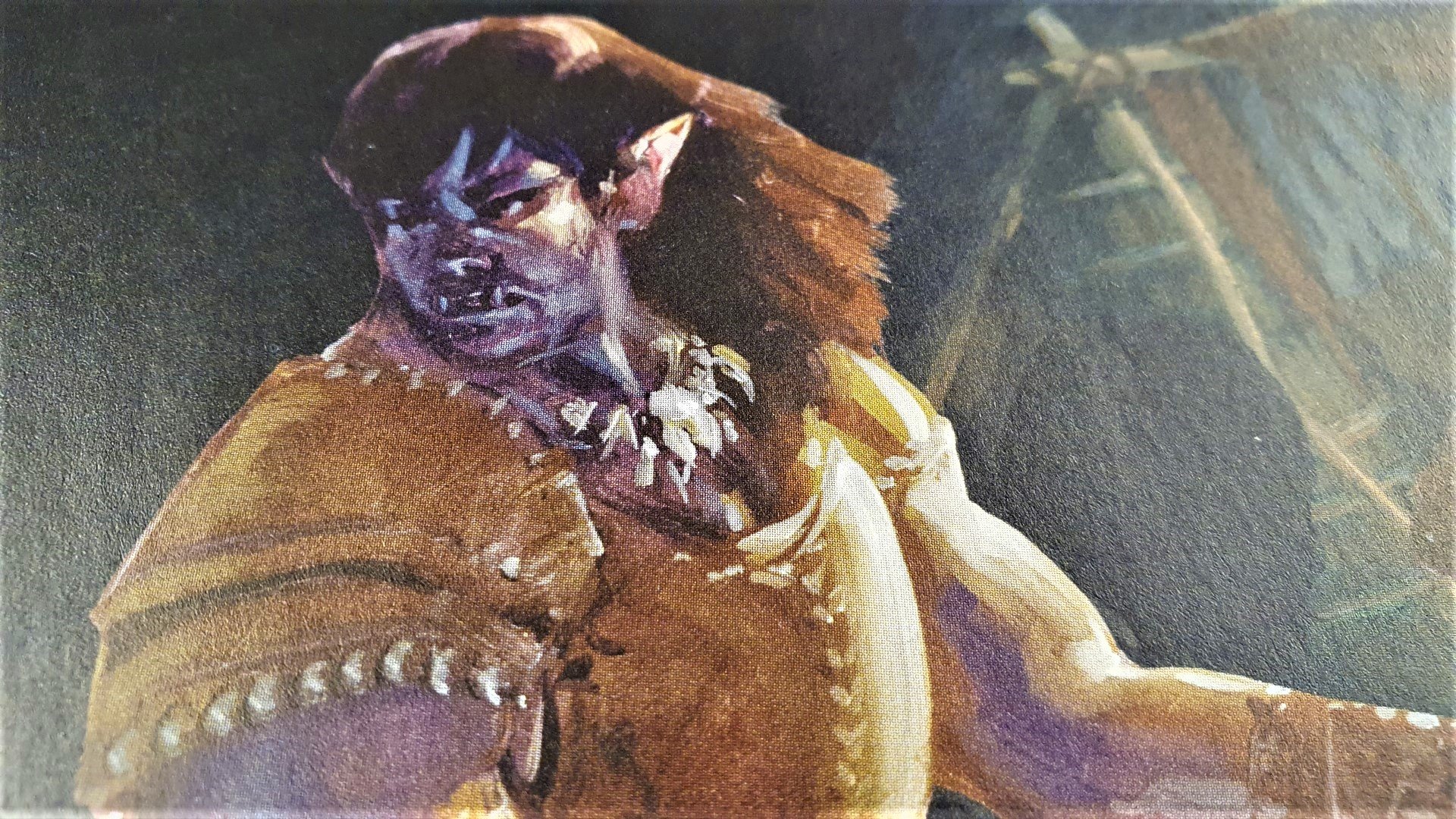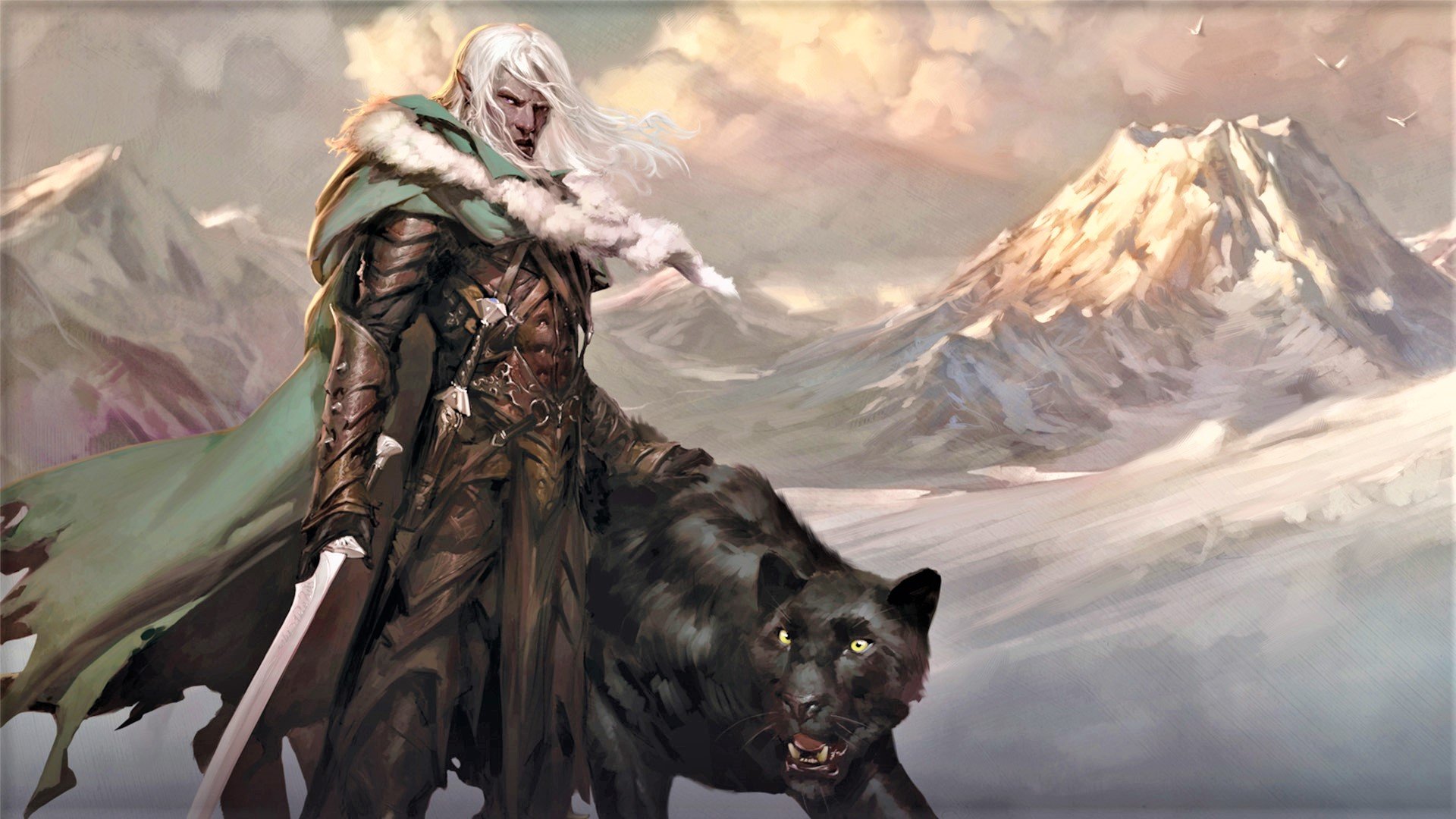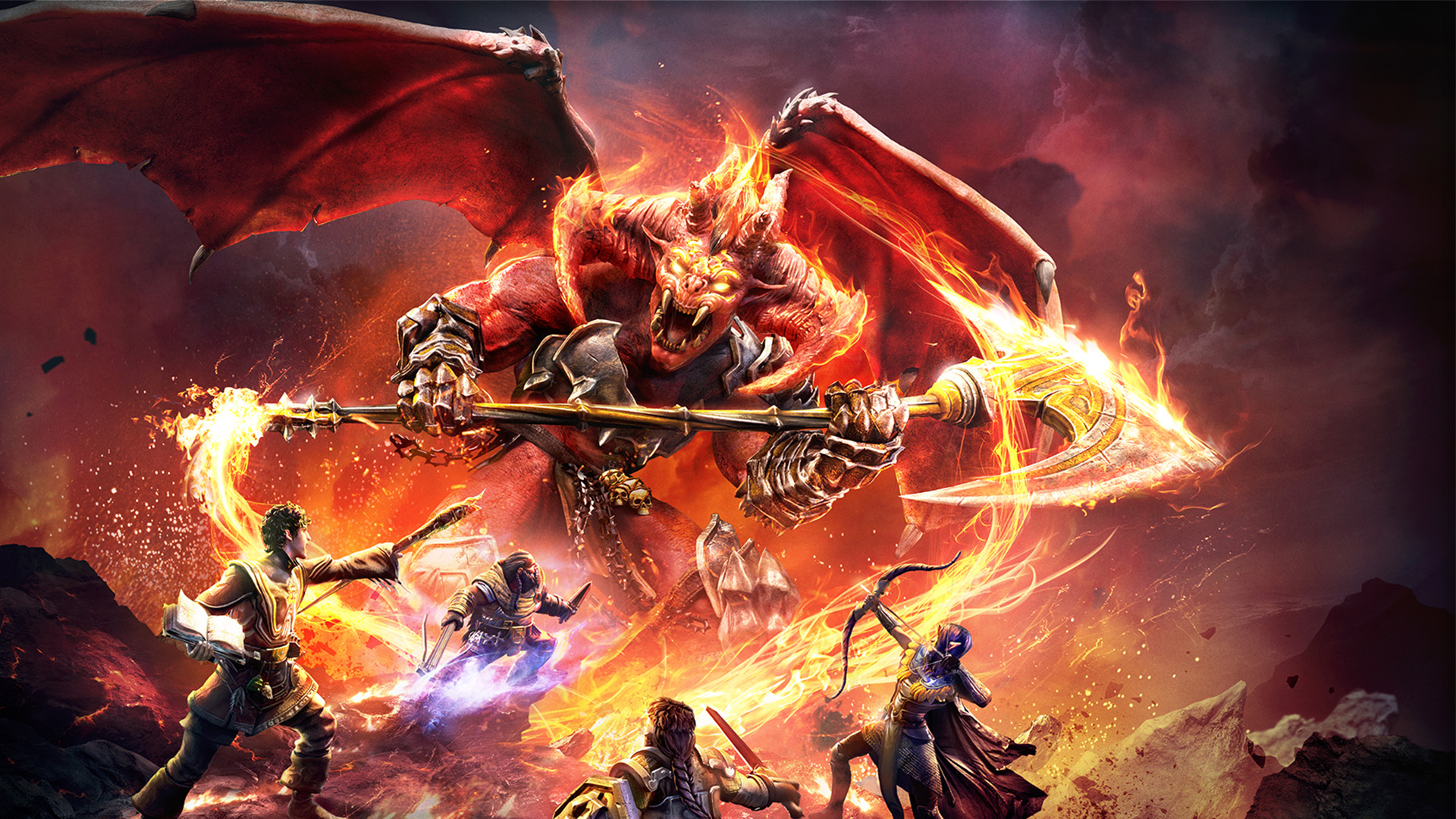The DnD Fighter 5e class is a classic part of any adventuring party, a master of martial weaponry who can tank hits and trade blows with enemies in the front line. This guide includes the complete official DnD 5e fighter rules, summaries of the many subclasses and expansions to the class, and our expert tips for how you can build the best fighter for your DnD campaign.
If you want to fill another role in your adventuring party, check our DnD classes guide for more information. Our in-depth guide to DnD races will help you complete your character concept.
First off, we’ll go through the official Fighter rules exactly as they appear in Wizards of the Coast’s open source DnD 5e System Reference Document, so you can get the basics down. After that, we’ll give our own expert advice to help you build your own Fighter, from subclass choices to full example builds we’ve tried out in-game.
Here’s all you need to know about the DnD Fighter 5e class:
- Fighter 5e class features
- Fighting styles 5e
- Second wind 5e
- Action surge
- Ability Score Improvement
- Extra Attack
- Indomitable
- Fighter 5e subclasses – martial archetypes
- The most important Fighter 5e stats
- Best Fighter 5e races
- Best Fighter 5e builds
- The best Fighter 5e feats
- One DnD Fighter base class changes
Fighter 5e class features
Hit Points
| Hit Dice: | 1d10 per fighter level |
| Hit Points at 1st Level: | 10 + your Constitution modifier |
| Hit Points at Higher Levels: | 1d10 (or 6) + your Constitution modifier per fighter level after 1st |
Proficiencies
| Armor: | All armor, shields |
| Weapons: | Simple weapons, martial weapons |
| Tools: | None |
| Saving Throws: | Strength, Constitution |
| Skills: | Choose two skills from Acrobatics, Animal Handling, Athletics, History, Insight, Intimidation, Perception, and Survival |
Equipment
You start with the following equipment, in addition to the equipment granted by your background:
- (a) chain mail or (b) leather armor, longbow, and 20 arrows
- (a) a martial weapon and a shield or (b) two martial weapons
- (a) a light crossbow and 20 bolts or (b) two handaxes
- (a) a dungeoneer’s pack or (b) an explorer’s pack
These are the features you’ll gain at each level:
| Level | Proficiency Bonus | Features |
| 1 | +2 | Fighting Style, Second Wind |
| 2 | +2 | Action Surge (one use) |
| 3 | +2 | Martial Archetype |
| 4 | +2 | Ability Score Improvement |
| 5 | +3 | Extra Attack |
| 6 | +3 | Ability Score Improvement |
| 7 | +3 | Martial Archetype feature |
| 8 | +3 | Ability Score Improvement |
| 9 | +4 | Indomitable (one use) |
| 10 | +4 | Martial Archetype feature |
| 11 | +4 | Extra Attack (2) |
| 12 | +4 | Ability Score Improvement |
| 13 | +5 | Indomitable (two uses) |
| 14 | +5 | Ability Score Improvement |
| 15 | +5 | Martial Archetype feature |
| 16 | +5 | Ability Score Improvement |
| 17 | +6 | Action Surge (two uses), Indomitable (three uses) |
| 18 | +6 | Martial Archetype feature |
| 19 | +6 | Ability Score Improvement |
| 20 | +6 | Extra Attack (3) |
Fighting styles 5e
You adopt a particular style of fighting as your specialty. Choose one of the following options. You can’t take a Fighting Style option more than once, even if you later get to choose again.
Archery
You gain a +2 bonus to attack rolls you make with ranged weapons.
Defense
While you are wearing armor, you gain a +1 bonus to AC.
Dueling
When you are wielding a melee weapon in one hand and no other weapons, you gain a +2 bonus to damage rolls with that weapon.
Great Weapon Fighting
When you roll a 1 or 2 on a damage die for an attack you make with a melee weapon that you are wielding with two hands, you can reroll the die and must use the new roll, even if the new roll is a 1 or a 2. The weapon must have the two-handed or versatile property for you to gain this benefit.
Protection
When a creature you can see attacks a target other than you that is within 5 feet of you, you can use your reaction to impose disadvantage on the attack roll. You must be wielding a shield.
Two-Weapon Fighting
When you engage in two-weapon fighting, you can add your ability modifier to the damage of the second attack.
The following fighting styles were added in Tasha’s Cauldron of Everything:
Blind Fighting
Nothing gets past you, literally. Fighters get blindsight with a ten feet range. Even when blinded or in complete darkness, you can see anything that isn’t behind total cover, meaning no more disadvantage imposed when attacking targets you usually wouldn’t see.
Unarmed Fighting
You can officially throw down in hardcore fisticuffs as a Fighter. Unarmed strikes deal 1d6 + your Str modifier of bludgeoning damage. If you aren’t wielding any weapons, that d6 turns into a d8. There is also the option to grapple an enemy and deal 1d4 damage at the start of your turn.
Superior Technique
If you want the perks of playing as a Battle Master subclass, without fully committing, this is a great fighting style to pick. Players can choose one of the many useful and powerful maneuvers from the Battle Master’s list for free.
Interception
When you are wielding a shield or a martial weapon, if you see a creature attack within a five-foot range, you can use your Reaction to leap in and intercede – lessening their damage roll by 1d10 + your proficiency bonus. This is especially useful if your party has lots of spellcasters with low AC.
Thrown Weapon Fighting
It acts exactly as it sounds; you can throw a weapon with the ‘thrown’ property. However, it also lets you draw multiple weapons in a turn, and adds a nifty +2 to your damage roll.
Second Wind 5e
You have a limited well of stamina that you can draw on to protect yourself from harm. On your turn, you can use a bonus action to regain hit points equal to 1d10 + your fighter level. Once you use this feature, you must finish a short or long rest before you can use it again.
Action Surge
Starting at 2nd level, you can push yourself beyond your normal limits for a moment. On your turn, you can take one additional action on top of your regular action and a possible bonus action.
Once you use this feature, you must finish a short or long rest before you can use it again. Starting at 17th level, you can use it twice before a rest, but only once on the same turn.
Ability Score Improvement
When you reach 4th level, and again at 6th, 8th, 12th, 14th, 16th, and 19th level, you can increase one ability score of your choice by 2, or you can increase two ability scores of your choice by 1. As normal, you can’t increase an ability score above 20 using this feature.
Extra Attack
Beginning at 5th level, you can attack twice, instead of once, whenever you take the Attack action on your turn.
The number of attacks increases to three when you reach 11th level in this class and to four when you reach 20th level in this class.
Indomitable
Beginning at 9th level, you can reroll a saving throw that you fail. If you do so, you must use the new roll, and you can’t use this feature again until you finish a long rest. You can use this feature twice between long rests starting at 13th level and three times between long rests starting at 17th level.
Fighter 5e subclasses – martial archetypes
At 3rd level, you choose an archetype that you strive to emulate in your combat styles and techniques, such as Champion. The archetype you choose grants you features at 3rd level and again at 7th, 10th, 15th, and 18th level.
Different fighters choose different approaches to perfecting their fighting prowess. The martial archetype you choose to emulate reflects your approach.
We have a separate guide that ranks the DnD Fighter subclasses from worst to best – here we’ve included a straightforward description of how each one functions.
- Champion
- Battle Master
- Eldritch Knight
- Arcane Archer
- Echo Knight
- Cavalier
- Samurai
- Banneret / Purple Dragon Knight
- Psi Warrior
- Rune Knight
Champion 5e
The Champion is a core Fighter Martial Archetype provided in the DnD 5e rules. It’s simply better at the core fighter activities of hitting things and being tough.
Champion 5e rules
| Level | Subclass abilities |
| 3 | Improved Critical |
| 7 | Remarkable Athlete |
| 10 | Additional fighting style |
| 15 | Superior Critical |
| 18 | Survivor |
Improved Critical
Beginning when you choose this archetype at 3rd level, your weapon attacks score a critical hit on a roll of 19 or 20.
Remarkable Athlete Starting at 7th level, you can add half your proficiency bonus (round up) to any Strength, Dexterity, or Constitution check you make that doesn’t already use your proficiency bonus.
In addition, when you make a running long jump, the distance you can cover increases by a number of feet equal to your Strength modifier.
Additional Fighting Style
At 10th level, you can choose a second option from the Fighting Style class feature.
Superior Critical
Starting at 15th level, your weapon attacks score a critical hit on a roll of 18–20.
Survivor
At 18th level, you attain the pinnacle of resilience in battle. At the start of each of your turns, you regain hit points equal to 5 + your Constitution modifier if you have no more than half of your hit points left. You don’t gain this benefit if you have 0 hit points.
How to play a Champion 5e
The simplest of all the subclasses, the Champion 5e is a safe bet for any beginners or players who enjoy handing out mass damage, with a minimum of planning.
At level three, Champions get Improved Critical, making any natural 19 count as a critical roll. As you level up, your crit chance can get up to three times higher than anyone else in your party, and all the double damage you’ll deal will be incomparable.
At level ten, an additional fighting style lets Champion players become more well-rounded or highly specialized, making this class a home run combat wise.
Now, if we’re completely honest, the straight-up-and-down Champion subclass can get a bit dull as you progress in the game. However, it’s still a great choice to experiment with 5e multiclassing, and stands as one of the best archetypes in terms of damage output.
Battle Master 5e
Wargamer has a dedicated guide to playing the the Battle Master 5e subclass: here’s the essential information you need to use the class.
Battle master 5e rules
| Level | Subclass abilities |
| 3 | Combat Superiority, Student of War, four D8 Superiority Dice, three Maneuvers |
| 7 | Know your Enemy, +1 Superiority Die, +2 Maneuvers |
| 10 | Improved Combat Superiority, +2 Maneuvers |
| 15 | Relentless, additional Superiority Die, +2 Maneuvers |
| 18 | Improved Combat Superiority |
Combat Superiority
The Battle Master gets special powers, called maneuvers, that are fuelled by superiority dice. They start with four D8s, and will gain more and increase the size of the dice as they gain levels. Superiority dice are expended to use maneuvers, and recovered after every short or long rest.
The Battle Master has access to a long list of maneuvers. They pick three at third level. maneuvers generally enhance an attack, providing a combat buff. You can’t stack two maneuvers on the same attack. If an enemy can save against a maneuver, the DC is 8 + Proficiency bonus + your choice of Str or Dex modifier.
Student of War
The Battle Master is proficient with one set of artisan’s tools of the player’s choice.
Know your Enemy
By spending at least a minute studying a creature outside combat, you can assess whether it’s your match, superior, or equal, in terms of combat prowess. You get to ask the DM for two bits of information, about how the creature’s Strength, Constitution, Dexterity, AC, current HP, class levels and fighter levels rank up against yours.
Improved Combat Superiority
At 10th level, and then at 18th level, your Superiority Dice rank up, first into D10s, then into D12s.
Relentless
A Relentless Battle Master that starts a fight without any superiority dice gains one.
How to play a Battle Master 5e
If you want to play as a Fighter who backs up deadly combat skills with some good old-fashioned creative tactical thinking, the Battle Master 5e is the subclass to pick.
Stand-out maneuvers like Trip Attack, which lets you knock enemies prone so your allies get advantage on their attacks are game-changers at low levels, and let Fighters control the battlefield as well as tank attacks.
Here is a class that lets you use your smarts, and generally upgrades the Fighter experience for the player. Also, it’s worth noting that you can get all your superiority dice back after a short rest – you always get to play with your cool class features.
Eldritch Knight 5e
Wargamer has a dedicated guide to playing the the Eldritch Knight 5e subclass: here’s the essential information you need to use the class.
Eldritch Knight 5e rules
| Level | Subclass abilities |
| 3 | Spellcasting, Weapon Bond, two Wizard Cantrips |
| 7 | War Magic |
| 10 | Eldritch Strike, +1 Wizard Cantrip |
| 15 | Arcane Charge |
| 18 | Improved War Magic |
Spellcasting
Eldritch Knights are Intelligence-based spellcasters that get access to abjuration and evocation Wizard Spells – these are the spells that provide protection from damage, or deal damage with elemental attacks. Their spell attack modifier is equal to their proficiency bonus + Int modifier, while the DC to save against their spells is 8 + proficiency bonus + Int modifier.
Weapon Bond
This magical ritual lets you bond with a weapon in your possession – this takes one hour, and can fit into a short rest without disrupting your healing or recovery. There’s no way to disarm the bonded weapon from an Eldritch Knight unless they’re incapacitated, and as long as they’re on the same plane of the multiverse, they can spend a bonus action to teleport it immediately into their hand. An Eldritch Knight can bond with up to two weapons.
War Magic
If the Eldritch Knight uses an action to cast a cantrip, they can make a weapon attack as a bonus action.
Eldritch Strike
After hitting a creature with a weapon attack, it has disadvantage on the next saving throw it makes against one of your spells. This lasts until the end of your next turn.
Arcane Charge
When you use your Action Surge you get a free teleport of 30 feet, before or after the bonus action.
Improved War Magic
If you use your action to cast a spell, you can make a weapon attack as a bonus action.
Eldritch Knight 5e Spell Slots
| Fighter Level | Spells Known | 1st level slots | 2nd level slots | 3rd level slots | 4th level slots |
| 3 | 3 | 2 | – | – | – |
| 4 | 4 | 3 | – | – | – |
| 5 | 4 | 3 | – | – | – |
| 6 | 4 | 3 | – | – | – |
| 7 | 5 | 4 | 2 | – | – |
| 8 | 6 | 4 | 2 | – | – |
| 9 | 6 | 4 | 2 | – | – |
| 10 | 7 | 4 | 3 | – | – |
| 11 | 8 | 4 | 3 | – | – |
| 12 | 8 | 4 | 3 | – | – |
| 13 | 9 | 4 | 3 | 2 | – |
| 14 | 10 | 4 | 3 | 2 | – |
| 15 | 10 | 4 | 3 | 2 | – |
| 16 | 11 | 4 | 3 | 3 | – |
| 17- | 11 | 4 | 3 | 3 | – |
| 18 | 11 | 4 | 3 | 3 | – |
| 19 | 12 | 4 | 3 | 3 | 1 |
| 20 | 13 | 4 | 3 | 3 | 1 |
How to play an Eldritch Knight 5e
The Eldritch Knight 5e is a Fighter who gains access to several DnD Wizard spells, primarily from the Evocation and Abjuration DnD schools of magic.
They can be thrilling to play, especially during characters’ earlier levels, as they wield magic while bashing all who stand in their way. Their level seven class feature, War Magic, lets you cast a DnD cantrip and use your bonus action to make a weapon attack on the same turn, making each turn feel way more rewarding in combat.
However, this subclass requires players to juggle Intelligence into their ability scores, and spell progression can feel slow. Level-up decisions get harder and harder, so be prepared to spend some time deliberating each choice.
Arcane Archer 5e
Wargamer has a dedicated guide to playing the the Arcane Archer 5e subclass: here’s the essential information you need to use the class.
Arcane Archer 5e rules
| Level | Subclass abilities |
| 3 | Arcane Archer Lore, Arcane Shot |
| 7 | Magic Arrow, Curving Shot |
| 15 | Ever-Ready Shot |
| 18 | Improved Arcane Shot |
Arcane Archer Lore
Arcane Archers get proficiency in either Arcana or Nature, and gain the Druidcraft or Prestidigitation cantrips.
Arcane Shot
While an Arcane Archer is armed with a shortbow or longbow, they can unleash magic through their arrows. This applies a bonus effect along with the normal bow damage. While you can only use this twice per short rest, you don’t have to declare that you’re using an Arcane shot until after the attack hits – unless the option you’re using doesn’t involve an attack roll.
To start with, you have two arcane shot options. You get two extra choices at level seven, 10, 15, and 18. If an opponent gets to save against an arcane shot, the DC is 8 + your proficiency bonus + Int modifier.
We explain all the Arcane Shot options in our Arcane Archer guide.
Magic Arrow
Nonmagical arrows that you fire from a shortbow or longbow still count as magical, so targets with resistance or immunity to mundane attacks and damage lose their protection. You can shoot ghosts!
Curving Shot
If you miss a shot with a magic arrow, you can make the arrow swerve towards a new target. This uses a bonus action, and lets you reroll the attack roll at a new target within 60′ of the original.
Ever-Ready Shot
If you start a battle with no uses of your Arcane Shot available, you regain one automatically.
Improved Arcane Shot
All your arcane shot options levels up into more powerful versions at level 18, gaining additional damage dice.
How to play an Arcane Archer 5e
As you progress in the Arcane Archer 5e subclass, the typical archer image is turned on its head, replaced with fancy tricks and thematic mechanics.
At the seventh level, all your arrows can be imbued with magic. Curving Shot uses your bonus action, letting you redirect arrows to different targets during combat, Wanted-style. If you feel inclined towards taking up a ranged Fighter, this is one of the more stylish choices.
However, be prepared to fully embrace your niche, as Arcane Archers are limited to using a bow. Unlike the other Fighter subclasses that offer a range of versatility, they’re fully locked into their role as a ranged damage dealer.
Echo Knight 5e
Wargamer has a dedicated guide to playing the Echo Knight 5e subclass: here’s the essential information you need to use the class.
Echo Knight 5e rules
| Level | Subclass abilities |
| 3 | Manifest Echo, Unleash Incarnation |
| 7 | Echo Avatar |
| 10 | Shadow Martyr |
| 15 | Reclaim Potential |
| 18 | Legion of One |
Manifest Echo
You can spend a bonus action to summon a ghostly echo of yourself within 15′. Once it’s on the battlefield, you’re tethered to it – if it’s more than 30′ from you at the end of your turn, it disappears from existence.
The echo is, functionally, a somewhat fragile second body for your character. On your turn you can move it up to 30′ without spending an action, and use your bonus action to spend 15′ of your movement and swap spaces with it.
When you take the Attack action, each of your Attacks can originate from you or from your Echo – likewise, you can spend your Reaction to make an opportunity attack with your Echo if an enemy moves away from it.
The Echo is pretty fragile – its AC is 14 + your proficiency bonus, and just 1 HP. Its saves are identical to yours. Echos also disappear if you dismiss them, are incapacitated, or you summon another one.
Unleash Incarnation
You can also make an additional attack from the Echo at the same time that you take a normal Attack action. You can use this power a number of times equal to your Constitution modifier (or once) per long rest.
Echo Avatar
By using an action, you can put your consciousness into your Echo, seeing through its eyes and ears instead of your physical body. While you’re projecting your mind like this the Echo can move up to 1,000′ away from you – this power lasts for 10 minutes.
Shadow Martyr
Once per short rest, you can use your reaction to teleport your echo into the path of an attack that targets another creature you can see. The Echo appears within 5′, and becomes the target of the attack instead of the original target.
Reclaim Potential
When one of your Echos is destroyed by taking damage, if you don’t have any temporary HP, you gain 2D6+ Con modifier temporary HP. You can use this power a number of times up to your Constitution modifier (opr once) per long rest.
Legion of One
You can now make two Echos simultaneously, and if you don’t have any uses of Unleash Incarnation left at the start of a combat, you regain one use of it.
How to play an Echo Knight 5e
What’s cooler than roleplaying as a mysterious Fighter who can summon a temporal duplicate of themselves?
At level three, the Echo Knight 5e can manifest their duplicate to fight alongside them, distract enemies, absorb party damage, and even teleport around the battlefield. If you like summoner gameplay, but want to try your hand at the Fighter, this subclass is a must.
Although the Echo’s abilities are limited outside combat, the Echo Knight is one of the most unusual Fighter archetypes you can play, and is a slap in the face to naysayers who reckon Fighters to be boring or vanilla…
Cavalier 5e
While the Cavalier is a skilled rider, most of its abilities are defensive and focused on punishing enemies that attempt to escape from its reach.
Cavalier 5e rules
| Level | Subclass abilities |
| 3 | Bonus Proficiency, Born to the Saddle, Unwavering Mark |
| 7 | Warding Maneuver |
| 10 | Hold the line |
| 15 | Ferocious Charger |
| 18 | Vigilant Defender |
Bonus Proficiency
Cavaliers gain proficiency in one language of their choice, or one of these skills: Animal Handling, History, Insight, Performance, or Persuasion.
Born to the Saddle
It’s hard to knock a Cavalier out of the saddle – so they have advantage to saving throws to avoid falling off. And if they do fall off (but fall 10′ or less, and are conscious), they land on their feet. Hopping onto or off a creature’s back only costs 5′ of movement, not half your movement speed.
Unwavering Mark
Cavaliers can mark a creature that they hit with a melee weapon attack – the mark lasts until the end of the Cavalier’s next turn (unless they’re incapacitated or killed first, or someone else applies a mark).
A marked creature has disadvantage on its melee attacks that target anyone but you as long as you’re within 5′ of it. If it somehow deals damage to another target, you’ll get the ability to punish it with a special attack during your next turn. This attack costs a bonus action, is made with advantage, and deals extra damage equal to half your fighter level.
You’re limited in the number of special attacks you can make – up to your Strength modifier (or at least once) per long rest.
Warding Maneuver
A number of times equal to your Con modifier (or at least once) per long rest, you can spoil enemy attacks with a reaction. When you or a creature within 5′ of you is hit by an enemy attack, roll a D8 and add it to the target’s AC. If they’re still hit, the target gets resistance to the attack’s damage (ie, the damage is halved).
Hold the Line
Creatures no longer need to leave your reach to trigger an opportunity attack – simply moving within you reach will let you react with an opportunity attack. And if you hit them, their speed drops to zero, effectively ensuring they can’t move past or around you.
Ferocious Charger
Once a turn, a Cavalier that hits a target after moving at least 10′ in a straight line before making its attack can try and knock the target prone. The target must pass a Strength saving throw against a DC of 8 + your proficiency bonus + Str mod, or land on their backside.
Vigilant Defender
You can make opportunity attacks as a reaction on every single other creatures turn (provided you don’t make another reaction).
How to play a Cavalier 5e
The image of a mounted knight immediately comes to mind for this subclass, but the truth is that they’re just as effective without a noble steed.
Cavaliers are great for defensive players, and especially for a campaign with lots of squishy spellcasters to look after. They demand more tactical thinking (reminiscent of fourth edition) so they can be incredibly rewarding for long-time players and combat enthusiasts to take on.
At level three, Unwavering Mark lets Cavaliers put enemies at Disadvantage, and gives their own attacks Advantage, if the creature targets one of their teammates. They also can grant extra AC, knock enemies prone, and generally add tons of buffing and protective value to an adventuring party.
Samurai 5e
Wargamer has a dedicated guide to playing the Samurai 5e subclass: here’s the essential information you need to get started.
Samurai 5e rules
| Level | Subclass abilities |
| 3 | Bonus Proficiency, Fighting Spirit |
| 7 | Elegant Courtier |
| 10 | Tireless Spirit |
| 15 | Rapid Strike |
| 18 | Strength before Death |
Bonus proficiency
Samurai gain proficiency in one language of their choice, or one of these skills: History, Insight, Performance, or Persuasion.
Fighting Spirit
Three times per long rest, the Samurai can spend a bonus action to gain five temporary HP and advantage on all weapon attacks until the end of their turn. At level 10 you gain 10 temporary HP instead, and at level 15 you gain 15 temporary HP.
Elegant Courtier
Samurai can add their Wisdom modifier as a bonus to Persuasion checks as well as their Charisma modifier. They also gain proficiency in Wisdom saving throws (or Intelligence or Charisma if they already have that proficiency).
Tireless Spirit
If a Samurai starts a fight within no Fighting Spirit remaining, they regain one use of it.
Rapid Strike
Once per turn, when a Samurai takes the Attack action and has advantage against the target of one of their attacks, they can choose to drop the Advantage and instead make an additional weapon attack against the same target.
Strength Before Death
As a reaction, after taking damage that would drop the Samurai to zero HP, they can stay conscious and immediately take an extra turn. They’re still considered to have zero HP for that turn, so extra damage will force them to take death saves as normal, but they remain conscious until the end of the turn. This ability can be used once per long rest.
How to play a Samurai 5e
One for the Overwatch Genji mains – if you like being the party’s striker, and thrive on an offensive playstyle, the Samurai 5e is for you.
Their Fighting Spirit ability lets players use their bonus action to gain more Hit Points, as well as an Advantage on all their attacks. It’s a pretty decent feature, but has limitations – as you can only use it three times before having to take a long rest. At level 15, Rapid Strike lets you forgo your Advantage for an additional attack, allowing players to absolutely wail on enemies with abandon.
Where Samurai shine most is in the higher levels, when Rapid Strike truly comes into its own. Still, since Fighters can gain Advantage in multiple ways, Fighting Spirit’s three-per-day limitation can feel jarring, especially for seasoned players.
Banneret 5e
Banneret 5e rules
| Level | Subclass abilities |
| 3 | Rallying Cry |
| 7 | Royal Envoy |
| 10 | Inspiring Surge |
| 15 | Bulwark |
| 18 | Improved Inspiring Surge |
Rallying Cry
When the Banneret uses its Second Wind, up to three allies that can see or hear you within 60′ each regain HP equal to your fighter level.
Royal Envoy
The Banneret gains proficiency in the Persuasion skill, or Animal Handling, Insight, Intimidation, or Performance if they already have it. They also enjoy a double proficiency bonus on their Persuasion skill.
Inspiring Surge
When the Banneret uses its Action Surge, an ally within 60′ that can see or hear the Banneret can use its reaction to make one melee or ranged weapon attack. At level 18, two allies can make the reaction instead.
Bulwark
When the Banneret uses its Indomitable ability to reroll an Intelligence, Wisdom, or Charisma save, one ally within 60′ that failed the same save against the same effect can reroll its save as well, provided it can see or hear the Banneret.
How to play a Banneret 5e
The Banneret 5e subclass (also called the Purple Dragon Knight in the the Forgotten Realms DnD setting) acts as something of a commander during campaigns. Their abilities add a lot of support in battle, and they are masters of persuasion.
Rallying Cry activates when they use their Second Wind power, granting hit points equal to their Fighter level to all allies in range. Their other ability, Inspiring Surge, lets a chosen ally use their Reaction to perform a full-on attack.
There is a lot of crossover with the Battle Master subclass’s maneuvers here, but with less versatility and power, making this subclass a tough sell among its peers. However, if you want to roleplay as a charismatic Fighter, The Purple Dragon Knight is worth looking into.
Psi Warrior
Psi Warrior 5e rules
| Level | Subclass abilities |
| 3 | Psionic Talent |
| 7 | Telekinetic Adept |
| 10 | Guarded Mind |
| 15 | Bulwark of Force |
| 18 | Telekinetic Master |
Psionic Talent
The Psi Warrior’s psychic powers are fuelled by Psionic Energy Dice. This has a number of dice in it equal to twice the Psi Warrior’s proficiency bonus, which are spent to use powers, and completely refreshed at the end of each long rest. Additionally, once per short rest the Psi Warrior can regain one die as a bonus action.
| Psi Warrior level | Psionic Energy Dice |
| 3 | D6 |
| 5 | D8 |
| 11 | D10 |
| 17 | D12 |
There are three psi powers available at level three:
- Protective Field – spend a die as a reaction to reduce the damage you or another creature within 30′ take as the result of an attack by the result + Int modifier.
- Pisonic Strike – once per turn, enhance a successful attack with one die + Int modifier force damage.
- Telekinetic Movement- as an action, telepathically move yourself, or a Large or smaller object or willing creature within 30′, by 30′.
Telekinetic Adept
The Psi Warrior gets two extra telekinetic options:
- Psi-Powered leap – as a bonus action, gain a flying speed equal to 2x walking speed until the end of the turn.
- Telekinetic Thrust – after making a Psionic Strike, force the target to make a Strength save against a target of 8 + proficiency bonus + Int modifier, or be knocked prone and moved 10′ feet in any direction.
Guarded Mind
The Psi Warrior gains resistence to psychic damage, and can spend a Psionic Energy die at the start of its turn to end every effect causing the Charmed or Frightened conditions.
Bulwark of Force
As a bonus action, the Psi Warrior can pick up to half its Int modifier (or at least one) creatures within 30′, to gain the benefits of half cover for one minute (or until it’s knocked out). It can include itself in this number.
This ability can be used once per long rest, or refreshed by spending a Psionic Energy die.
Telekinetic Master
The Psi Warrior can cast the Telekinesis spell without using any components once per long rest, or by spending a Psionic Energy die. While concentrating on the spell, the Psi Warrior can use its bonus action to make a weapon attack. Its spellcasting ability is Intelligence.
How to play a Psi Warrior 5e
Ever wanted to be a Jedi traversing through the Forgotten Realms? Well, playing as a Psi Warrior will probably be as close as you’ll get.
Like the Eldritch Knight, they combine melee with magic – but Psi Knights also have a mechanic similar to the Battle Master’s superiority dice, when using their Psionic powers. Along with mimicking aspects from these subclasses, they’re a lot easier to play in general, thanks to their fixed set of built-in options.
Unfortunately, players will need to pay extra attention to their ability scores, as Psi Warriors’ powers – like Eldritch Knights’ spells – are often dependent on Intelligence.
Rune Knight 5e
Wargamer has a complete guide to playing the Rune Knight 5e subclass: here’s the essential information you need to get started.
Rune Knight 5e rules
| Level | Subclass abilities |
| 3 | Bonus proficiencies, Rune Carver, Giant’s Might |
| 7 | Runic Shield |
| 10 | Great Stature |
| 15 | Master of Runes |
| 18 | Runic Juggernaut |
Bonus proficiencies
The Rune Knight is proficient with smith’s tools, and is proficient in the Giant language.
Rune Carver
The Rune Knight knows how to enchant mundane objects — weapons, armor, shields, or jewellery – with ancient Giant runes. Each item must receive a different rune. The Rune Knight knows how to make a fixed number of runes, but can swap runes in or out each time they gain a Fighter level.
| Fighter Level | Runes Known |
| 3 | 2 |
| 7 | 3 |
| 10 | 4 |
| 15 | 5 |
Runes have a permanent static effect, and a more powerful effect that can be invoked once per short rest for a temporary bonus.
For full details of the different runes, see the full guide to the Rune Knight 5e subclass.
Giant’s Might
A number of times per day equal to their proficiency bonus, the Rune Knight can spend a bonus action to become magically swollen with giant power. Provided there’s space to expand they become Large (if they aren’t already), they gain advantage on Strength checks and Strength saving throws, and once per turn, one of their weapon or unarmed attacks deals an extra D6 damage. The effects last for one minute.
Runic Shield
A number of times per day equal to their proficiency bonus, the Rune Knight can use a reaction to force an enemy that has made a sucessful attack against someone within 60′ to reroll the attack roll.
Great Stature
The Rune Knight permanently grows 3D4″, and presumably has to have all their clothes refitted. Their Giant’s Might damage bonus increases to D8.
Master of Runes
The Rune Knight can invoke each rune for greater effect twice, instead of once, per short rest.
Runic Juggernaut
The Rune Knight can grow even larger when they transform with Giant’s Might, inflicting D10 bonus damage instead of D8, growing up to Huge size, and (when that large) gaining an extra 5′ reach.
How to play a Rune Knight 5e
The Rune Knight 5e enhances their equipment through the use of ancient runes passed down from Giants. A general note to remember is that players of this subclass will want to focus on their Con score to power their rune magic effectively.
This subclass makes a great tank option. With abilities like Runic Shield (which forces enemies to reroll attacks) and Giant’s Might (which lets them apply extra damage), these folks can be invaluable party members.
Rune Knights are a powerful subclass, both in the early and late games – but require resource management skills to unlock their full potential.
The most important Fighter 5e stats
The Fighter class generally has two paths players can take, and which one you choose will dictate the best ability scores for you to work on. You can choose to be a ranged Fighter, focusing on your Dexterity (Dex) score, or a baddie-bashing melee maniac – which is based around your Strength (Str).
It’s purely up to you which DnD stats to focus on maxing out. However, no matter which type of Fighter you end up picking, remember to raise their Constitution (Con) score, too. After all, you can’t have a beefy damage dealer that gets knocked out at the drop of a helmet, right?
Best Fighter 5e races
For an optimal Fighter build, you’ll generally look towards DnD races that will give some juicy bonuses to your key ability scores. Choices that will increase Dex, Str or Con are sure-fire ways to take your characters up a notch.
Mountain Dwarf Fighter
Mount Dwarfs get a +2 Str and +2 Con. That’s right, a total of four points of score improvements, adding up to one of the best choices for tanks and strength-focused Fighters. You also get some free resistance to poison thrown into the mix. What more could you ask for from a DnD Dwarf?
High Elf Fighter
With their +2 bonus to Dex, +1 to Intelligence (Int), dark vision and proficiency in perception, a High DnD Elf makes a super-effective ranged Fighter. Their Intelligence bonus also helps pump up secondary ability scores, to benefit subclasses like the Eldritch Knight. Bear in mind that their Elven Accuracy feat grants a huge damage increase as well, so if you’re planning to be an archer, or a Fighter dabbling in magic, it’s a solid pick.
Dragonborn Fighter
This race will give Fighters a +2 Str and +1 to their Charisma (Cha), great for melee players looking to beef up their stats. Dragonborn 5e Fighters also get Breath Weapon, an innate ability that lets you damage multiple enemies at once, getting past the typical and limiting single-target attack styles dominant in the Fighter class.
Variant Human Fighter
The Variant DnD Human will let players add a point to any two ability scores of their choice, gain proficiency in any skill that tickles their fancy, and, finally, even grants an extra feat. For any Fighter characters, these perks combined make for a pretty amazing deal.
Half-Orc Fighter
Here, you get a +2 Str and a +1 Con, making Half-Orcs great from an ability score perspective straightaway. But what truly makes them stellar picks is their Relentless Endurance and Savage Attack racial abilities, making Half-Orc Fighters tough to take down, while hitting extremely hard.
Best Fighter 5e builds
Now that you’re familiar with how the Fighter performs on paper, here are some play-tested Fighter 5e builds to help you put yours together.
Elven Samurai
For the Overwatch Hanzo mains. When you think about a traditional image of a Samurai, an Elven archer may not immediately come to mind, but hear us out; it’s totally worth it.
A Dex-focused Samurai that has the Elven Accuracy feat, paired with Sharpshooter, is terrifying. The mass damage they can deal in a single turn, plus their Rapid Strike ability, will let players dominate combat.
Ability scores
You’ll want to max out your Dex as soon as possible. Focus on Con next, but (and we can’t stress this enough) your Dex directly impacts damage scaling, and is by far the most important to pay attention to as you keep levelling.
Details
- Pick the High Elf race, giving you +2 Dex, the Elven Accuracy feat and Dark Vision.
- Take a longbow for your primary weapon and choose the Archery fighting style. This will give a bonus to your ranged attacks.
- At the third level, once you pick the Samurai subclass, you will gain the option for a bonus proficiency. Persuasion is a good choice that meshes well with the Samurai archetype, which leans more into being the party face and charismatic Fighter.
- At level four, take the Sharpshooter feat. This feat, paired with the Samurai’s Fighting Spirit ability, is deadly. Fighting Spirit’s Advantage, paired with Sharpshooter’s damage bonus, likewise equals mind-blowing power in early levels.
- At level six, take the Elven Accuracy feat; this will give a bonus to an ability score of your choice and attack rerolls. Now you get to roll three dice when you have Advantage, further increasing your chance to hit, crit and attack.
- At level eight, you get an ability score improvement. Here you will want to max out your Dex if you haven’t already.
- From here on out, the core build is pretty much in place, and the rest of the build’s decisions can be catered especially to each player’s roleplaying preferences.
Human Polearm Battle Master
The sentinel Polearm Master often comes up when talking about optimized builds in D&D 5e. It’s an option that does a lot – and we mean a lot – of damage.
You can weaponize both your Bonus Actions and Reactions, attack from a distance, and keep enemies at bay. They are one of the strongest melee builds in the game, and can be an overpowering force on the battlefield.
Ability scores
You’re going to be a heavy weapon Fighter, so, naturally, your character is going to need a pretty sizable Str score, closely followed by Con. Your secondary focus, after maxing these, should be your Dex.
Details
- Choose the Human Variant Race, and with their free feat, take Polearm Master; this will give extra bludgeoning damage to your attacks. Use their ability score bonus for your Str and Con.
- You will want to take a Reach weapon in this build. Choose a glaive or halberd, and get some heavy armor to top it off.
- For your fighting style, pick Great Weapon Fighting; this will give you the option to reroll any annoying ones or twos for better damage. This, paired with the bonus from the Polearm Master feat, makes you pretty scary straight away.
- At level three, pick the Battle Master archetype, giving you three maneuvers. They are all pretty good; however, we recommend picking Menacing Attack for a further 1d8 bludgeoning damage, and Lunging Attack to extend your reach.
- At level four, take the Sentinel feat; this will stop in-range enemies’ movements completely, and gives tons of chances for opportunity attacks.
- At level seven, you get more maneuvers; if you’re unsure about which ones to pick, Trip Attack is always a great choice.
- From here, all you need to do is keep raising your ability scores, and add to your maneuvers list. Once you gain that Sentinel feat, you’re pretty much sorted.
Two-Hander Half-Orc Champion
If you live for landing multiple crits and stacking up that sweet, sweet damage, here is the build for you. Two-hander Champions are all about maximizing each attack by hitting very hard, aiming to strike down foes in a single turn.
They are incredibly satisfying to play in combat, and an excellent introduction for the Fighter class in general. I mean, what else can get players into the roleplaying mood more than obliterating enemy creatures with a single swing of a giant sword or hulking ax?
Ability scores
Like the Polearm Master, you will be handling heavy weapons, so raising your Str will be your priority. Two-hander Champions will also need to raise their Con, as they’ll probably be in the frontlines, taking hits from enemies.
Details
- Pick the Half-Orc race. This will give your Fighter +2 Str and +1 Con. You will also get access to the Savage Attack power.
- For weapons, Fighters should take a Greataxe, as, when paired with the Half-Orc’s Savage Attack ability, this will give you an additional bonus on any critical hits. Paired with the Champion’s subclass feature of an extra critical chance, this becomes super-powerful
- The Great Weapon fighting style is a must, letting Fighters increase their crit damage even further.
- At the third level, the Champion archetype will give players an increase to their critical rate with Improved Critical, letting your Fighter deal out more damage.
- At Level four, take the Savage Attack feat. This will let you roll damage dice again on a critical hit.
- Level six gives players another feat or ability score improvement. Pick the Lucky feat to roll an additional d20.
- Finally, at level ten, you will have the chance to pick an additional fighting style. Here, it depends on your party role. A good shout would be taking Protection to aid allies, making enemies roll with Disadvantage after a hit. Or take Defense to boost up your AC, making it even harder to take you down.
- By following this core build, you will be landing a lot of critical rolls, and dishing out scary amounts of damage.
The best Fighter 5e feats
Your first focus should be maxing out either your Str or Dex for powerful Fighters, then raising your Con. However, if your abilities are already maxed out, here are the best 5e feats for your Fighter to grab when leveling up.
Great Weapons Master
A must for melee Fighters using two-handed weapons. This feat gives Fighters a bonus action any time they get a critical or kill an enemy. It can also increase damage output, as players get the option to take a -5 penalty to their attack roll in exchange for +10 to their damage roll.
Shield Master
This allows Fighters to use their shields to knock back enemies. They can also use their shield’s AC to assist in any saving throws.
Sharpshooter
This is essential for ranged Fighters. Sharpshooter prevents disadvantage being applied to any long-ranged attacks. It also offers an increase in overall damage, as Fighters get the option to take a -5 to-hit penalty, for a potential +10 to their damage rolls.
Resilient
With this feat, Fighters get to increase an ability score, and then gain Proficiency in saving throws for that ability. This can be useful in boosting your Fighter’s Wisdom (often a weak area for Fighters), generally making it harder for spellcasters to charm or control your character.
Crossbow Expert
If Fighters are carrying a loaded crossbow, this lets them use it for a bonus attack, any time they make an attack with a one-handed weapon in combat. What Fighter doesn’t want an extra opportunity to deal more damage?
One DnD Fighter base class changes
With One DnD coming out in 2024, all the game’s classes are about to be shaken up. But the Fighter is one of the classes that’s seeing the least change between base 5e rules and One DnD.
Still, that doesn’t mean it’s staying completely the same. There are plenty of tweaks to be aware of for the One DnD Fighter.
For instance, the Fighter is the class who benefits most from the new Weapon Mastery system, a feature that gives you an extra special move with a weapon, like knocking an enemy prone or cleaving to a second opponent. The Fighter gets to have masteries for more weapons than any class, starting out with three and ending up with six. You’ll need to have a backpack stuffed full of pointy things!
Other changes include the ability to switch your Fighting style feat between levels. Second Wind has been changed, so you can use it twice without resting, but only regain one ‘charge’ when you take a short rest. And there are all sorts of tweaks for the various Fighter subclasses…
One DnD Fighter subclass tweaks
Battle Master
- Student of War gives you proficiency, not just with a type of artisan’s tools, but also with a skill.
- Know Your Enemy now works in combat. You can learn about another creature’s resistances or vulnerabilities as a bonus action, but only once per long rest – unless you expend a superiority die.
- Relentless lets you use a Maneuver without using a superiority die, but with a smaller die roll.
- The Maneuvers from Tasha’s Cauldron of Everything are included in the main rules.
Champion
- New utility feature, Remarkable Athlete, gives advantage to Strength Athletics checks and Initiative checks. It also makes you a better jumper.
- Heroic Warrior is another new feature, which gives you Heroic Advantage (otherwise known as Inspiration) in combat, whenever you begin a turn without it.
Originally, Wizards of the Coast planned to create a brand new Fighter subclass, the unarmed Brawler. However, this fared poorly in playtests, and was soon scrapped by the designer.
Ready to get fighting? Here’s some more tools you might want to use in your next DnD campaign. We can recommend the best DnD miniatures – or, if you like things simpler, here’s our DnD campaign case review.
This guide directly presents rules text for the DnD 5e Fighter class, published by Wizards of the Coast under a Creative Commons Attribution 4.0 license.


